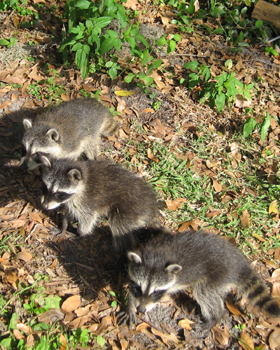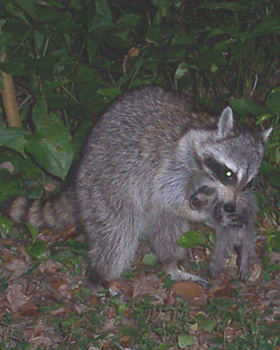The two things everyone thinks they know about raccoons are that they look as though they are wearing a mask over their eyes and that they like to wet their food before eating it. They don't always like to wet their food, but they do look like ring-tailed masked bandits, and sometimes
they act like bandits too! There are so many more things about raccoons that are worthwhile knowing, however. It is worth exploring how they live and behave in their natural surroundings.
Natural Habitat
They prefer to live near water, likely because they enjoy dining on crayfish, fish and other foods they can find in the water. Even though they do have salivary glands, raccoons seem to have a need to wet their food prior to eating it. This may be the reason why they love to be near water but it brings up the question why they need to wet their food. Raccoons live in wooded areas but have found homes in urban areas as well. When they live in the forests, their preference is a hardwood forest near a little stream. They will live in marshy areas and bogs but because of land development, are now also found in drier areas.
The only types of terrain they avoid but in which they can still be found, are open fields, prairies and deserts. Raccoons make their dens in tree cavities. Sometimes they burrow into the side of dirt banks or under trees between roots.
Urban Habitats
When their homes are encroached upon by developments of houses, they can fairly easily adapt to new habitats. In fact, it's now understood that raccoons, for the past several decades, have been in the process of becoming urbanized animals, like pigeons or rats. Raccoon population densities are
typically much higher, up to ten times higher, in cities than in the native forests. In cities, they will often live within strips of trees and vegetation if possible, but will commonly find other developed areas in which to settle as well. If they cannot be near water, they will have no qualms about using an animal trough, a swimming pool or a bird bath to douse their food. In this micro-environment, raccoons have a much diminished rage of foraging. In the woodlands, females usually have a range of eight to eighty acres while males roam up to two hundred acres of territory. Living in an urban area, raccoons don't tend to roam that far because they don't have to. Wherever people live there is food to be found. Raccoons have their personal fast food sources without the need to roam. They can also find shelter quite easily in attics, sheds, basements, crawl spaces as well as abandoned cars.
Biology Of The Raccoon
Their appearance is very distinctive. Their fur is gray but sometimes it is also mixed with fur of a yellowish hue, especially during shedding times. The most distinguishing feature is the black mask that surrounds the eyes. In the middle of the mask on either side of the face is a little black eye. The raccoon has rounded ears, a pointed nose, and white whiskers. Its claws are sharp and adapted to climbing. A mature raccoon is about three feet long of which one foot is a bushy tail that is ringed with alternately lighter and darker fur. Depending on the availability of food, it can weigh up to forty pounds. The raccoon's five toes are able to grasp food with amazing dexterity.
Food
Although it is an omnivore, the raccoon is quite fond of sea food. Crayfish, snails, clams and frogs are preferred but it will eat just about anything if seafood isn't available. It will eat rats and mice and even snakes if the opportunity presents itself. Pet food, garbage, bird eggs, fruits, nuts and vegetables round out a raccoon's diet.
Mating Habits
The female and male raccoons generally do not care for one another except during mating season. Breeding can happen anytime between January and June although the season's peak is between March and April. Females can breed when they are one year old. Fertility lasts only three or four days. During that time the female can mate with one or more males. Copulation lasts for about an hour or more and is repeated throughout her fertile time. Even the weaker males will be accepted for breeding because the alpha males cannot possible breed with every single female.
The gestation period for the female raccoon is normally about 65 days after which the female delivers usually two or three kits, although up to five kits are possible. When the female is ready to give birth, an altercation between the male and female often happens. She does not want the male around. She kicks him out of her den because male raccoons are not the nurturing kind. In fact, her babies are in great danger of not surviving longer than birth so long as their sire is near.
Care Of The Cubs
The kits, or cubs, are born blind and deaf. The female is the only parent to care for the offspring. Males are generally quite aggressive toward their young and would kill and eat them. After about three weeks the kits' hearing begins to function and a few days after that, their eyes open. Until the kits are about seven weeks old, they do not leave the den. After that, when they weigh about two pounds, they will follow their mother and soon become more independent. The young will stay with their mother throughout the fall and winter. The next spring, they will leave their mother and find dens of their own. Females frequently stay close to their mothers. Males often move a distance of up to twenty miles away from their mothers. It is assumed that this is instinctive to prevent inbreeding.
More information about raccoons:



